Telephone ~ 230.PZ: 1878-1889;
PZ.230: 1889-1916.
The Newlyn based fishing lugger Telephone, was registered as a Sea Fishing Boat, in the registers kept by the Penzance Custom House officers, on July 4th, 1878.
The choice of name was a topical one. Alexander Graham Bell having patented his first telephone in 1876, with other inventors quickly introducing adaptions and improvements, most notably those of telegraph proprietor Thomas Edison in August 1877, and the invention of the carbon microphone. The ‘Telephone’ in all its forms was a world-wide topic of conversation and increasing speculation.
The Mount’s Bay fishing boat Telephone was registered by Philip Tonkin, of Newlyn, as her sole owner and skipper. She was registered as a 14-ton lugger, by measurement, which measurement had nothing to do with her weight, or displacement, but was a formulaic calculation of her internal carrying capacity, or volume. As she was less than 15 tons by this measurement, the current fishery regulations deemed her to be a second-class fishing boat – which again was nothing to do with how well she was built and maintained, but was a notional classification set by the regulations. As such, on registration she was allocated the Port of Penzance fishery number 230.PZ.
Simply recorded as a ‘Lugger,’ with her normal mode of fishing by means of ‘Drift Nets,’ she had a keel length of ‘45 feet,’ and was usually worked by a crew of 6 men (including skipper Tonkin) and a boy.[1] Throughout this history, I have used the term ‘skipper,’ rather than captain, for the man in charge of the boat. These boats were worked by share-fishermen, that is to say that each of the crew received a share in whatever sum their catch sold for after each fishing trip, or at the end of each week, receiving no wages for time served. In the Mount’s Bay boats the catch was divided into seven shares; one-seventh went to the owner of the boats as the ‘Boat’s share.’ The remaining six-sevenths was divided into two; one half of which was divided equally between all of the men (the crew including the skipper), as their ‘Body share;’ the other half was divided proportionally amongst the providers of the fishing nets, being the ‘Nets’ share.’ The whole train of drift nets worked, consisted of numerous ‘pieces of net,’ which were laced together to form the train. Pieces could be provided by crew members, widows of friends and/or relatives. The whole being a community enterprise, with labour much on the same par as capital. Steam capstans, when they were introduced, were also allowed a ‘share’ to cover the running costs, but they also increased the fishing power of the boat, in that lengthier trains of nets could be employed, and hopefully more fish could be caught.
Unfortunately, this generation of British Sea Fishing Boat registers [from 1868] were simple affairs, intended just to provide basic statistical information on the numbers of fishing boats actively employed in the several ‘Ports’ of register, year by year, together with the number of men and boys so employed. In this period, they contained no information on where and when the boats had been built, nor yet who built them. Entries were made chronologically, and fishing numbers were allocated by the registrar from a ‘spare numbers’ list
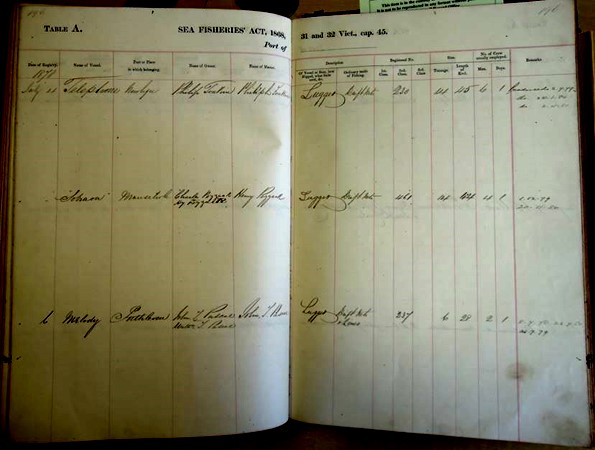
Telephone’s entry is at the top of the page
Kresen Kernow: MSR/PENZ/5, folio 196
However, while the register does not record who built the boat, or where or when she was built, in the case of the Telephone one of the local papers carried a dramatic account of her launch from Batten’s Wharf, Penzance, on the evening of Tuesday, 18th June, 1878. Her builders being the brothers, Edwin and Walter Semmens, whose building plot was on Sandy Bank, to the rear of Batten’s Wharf. Three months previously on March 2nd, the Semmens brothers had launched the Alarm ~ 24. PZ, a fully decked lugger with cabin aft, for Mr. Henry Downing of Newlyn.
At the time of the launch of the Alarm, the brothers were already busy working on the new boat for Mr. Philip Tonkin, of Newlyn.
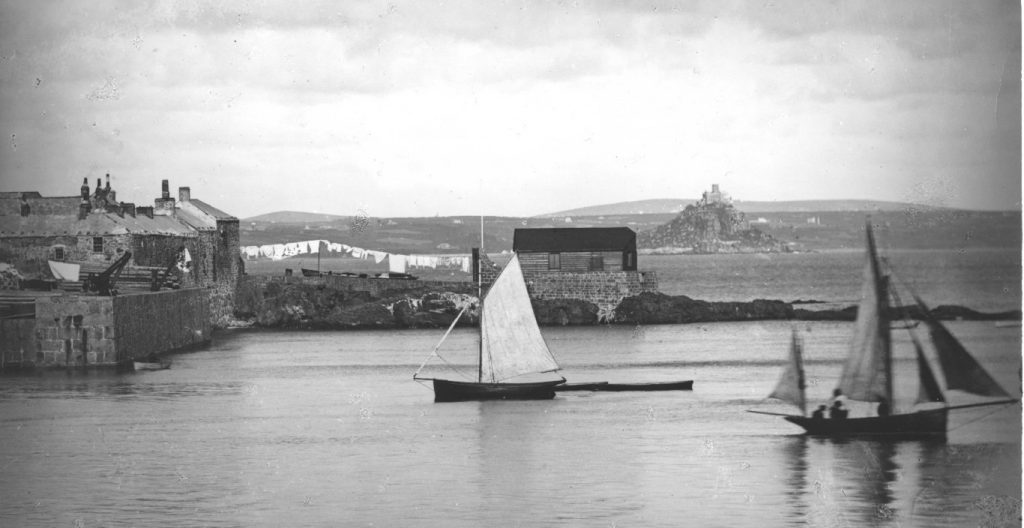
NARROW ESCAPE AT A BOAT-
LAUNCH.
The two or three hundred people who assembled on the Eastern Esplanade, Penzance, on Tuesday evening, to witness the launching of the mackerel-boat, Telephone from Batten’s Wharf, were witnesses of a mishap which narrowly escaped being a catastrophe. The Wharf is by no means an easy place from which to launch a vessel, and the arrangements in this case were simply made. The boat was built on the pier, and had to be carried on and slewed round to pass out at a gap in the wall. From this gap to the beach below ran ways or skids; and the simple plan was by pulleys and ropes to get the boat on the ways, tilt her up, and let her slip into the water by virtue of her own weight. About half-past six, when the tide was nearly high, the Telephone was got into position for tilting, bow foremost, and a shipwright ran down and greased the skids for a little way; two flags were hoisted on jury-masts, and then scrambled on board Capt. Joseph Semmens, of the Wellington, trader between Penzance and Plymouth; James Richards, who is to sail in her; a man named Tonkin, of Newlyn, brother of the owner; another workman, and two boys, one being the son of Tonkin. Then the shipwrights on the Wharf hauled at the tackle, the boat tilted, with a very considerable list shorewards, and running for a foot or two, worked herself out of the ways and fell completely on her side in the water, the stern just clearing the wharf – the wall of which was crowded. Tonkin and Richards jumped off the deck as soon as they saw she would fall, so as to prevent themselves being caught under her in vase she toppled right over, deck down. Capt. Semmens, and one of the boys were pitched out, whilst the other workman who had sat right in the stern clung to the gunwale, holding on Tonkin’s little boy, till the boat righted, which she commenced to do as soon as her quarter struck the sea, although she took in a great deal of water over the combings of the hatchway. The mishap caused a most painful excitement amongst those on shore, who commanded a full view of the launch, As the boat fell immediately after being tilted and at the highest point in the ways, it looked as if the boat must turn completely over on its occupants. Indeed, at first, in the confusion, it was feared that this had really happened. As the water in which the three men and a boy had fallen from a height of many feet, was not over four of five feet deep, there was no danger of drowning, but it was not certain at first that the vessel had not fallen on and injured some of them. Capt. Semmens was thought to be hurt, for he, unlike Richards and Tonkin, did not rise to his feet, but lay like a log in the water, his back just showing. To his help, from off the wall of the Wharf, Richard Hicks, a noted swimmer, jumped, and, with the aid of others who rans out into the water, pulled Capt. Semmens ashore, and he soon recovered. He had not been struck, but was so dazed and stunned by the fright and the fall that if he had been left to himself, he, in all probability, would have been drowned. Tonkin, who had no thought of his child when he jumped off the falling boat, began to run to shore as soon as he regained his footing, and then, suddenly recollecting his boy, turned round, and in the most frantic manner shouting, “My child, my chid, he’s drowned, he’s Killed.” He rushed back into the water, and, was greatly alarmed at not being able to see his son there. And, when he caught sight of his boy in the boat, which had by this time righted itself, the father was not satisfied till he had got him ashore. The accident was foretold in the morning, but no heed was paid to the warning. The mishap arose in consequence of the skids not being wide enough to take the boat between its bilges, and this fault was aggravated by the fact that the Telephone was launched bow first. The result was that the sharpest end of the boat went into the skids first, and, as the broader part came on, the boat gradually wedged itself out of the ways till it fell. Another fault was that the way nearest the shore was lower than that seaward, and one person attributed the accident to the fact that the men at the western tackle hauled away too fast. When the excitement was over, there was among the crowd a feeling of relief that a mishap that had threatened so seriously at first had resulted in so little injury.
Mr. Edwin Semmens, one of the builders of the Telephone, writes us to explain that he and his brother were not answerable for the mode in which the boat was launched. It was the owner who decided that she should take the water bow foremost, and he had fully exonerated the builders from all blame, and expressed himself well satisfied with the boat, which was in no way damaged. We have also learnt that it was against the express wish of the builders that there were any persons on board the boat for the launch; and that practical men are of opinion that if the Telephone had been launched sternforemost no mishap would have happened. The boat, which Messrs. Semmens will begin shortly, is to be built for Messrs, Matthews Brothers, fishermen, of Mousehole, and not for Messrs. W. B. Mathews and Co., of Penzance, as previously stated.[3]
The Cornish Telegraph, Tuesday, June 25th, 1878
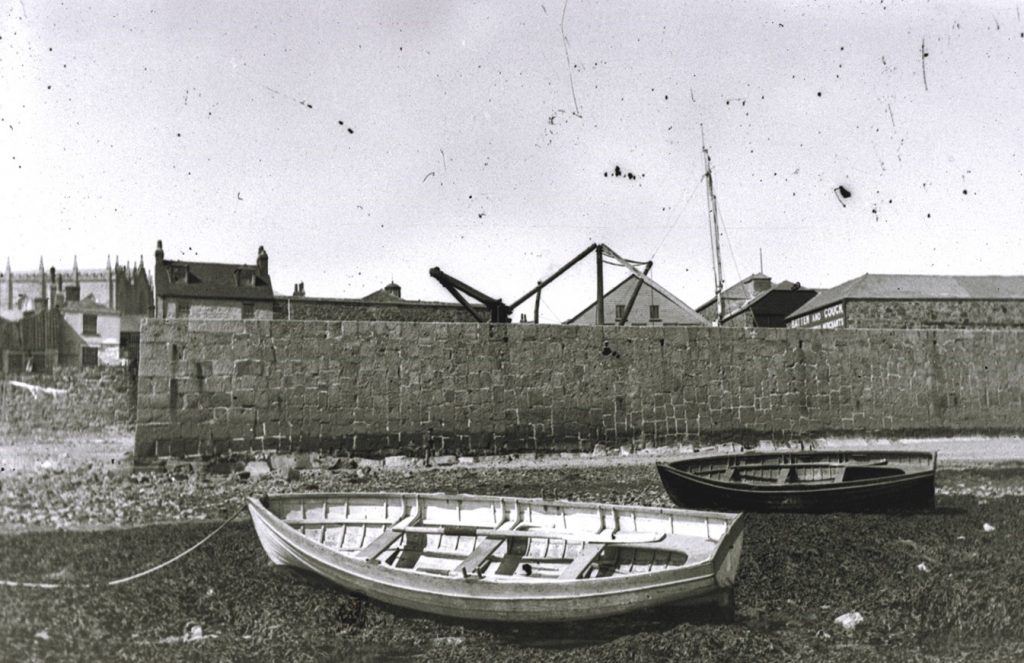
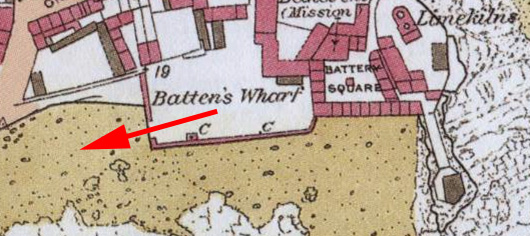
Out of Newlyn
Working out of Newlyn, in local parlance the Telephone was a ‘mackerel driver,’ that is to say a fully decked lug rigged fishing boat, primarily built to prosecute the great western mackerel fishery, which in that period was the principal Mount’s Bay fishery. However, for some reason she was completed too late to participate in that fishery in 1878. It was a seasonal fishery, extending from about February to June each year – by which time the mackerel shoals were out-deep to the west of the Isles of Scilly, and beyond economic reach. For boats of her size, this still left seven months of the year to be filled by alternative fisheries – wherever. She was a little on the large size for the summer pilchard fishery in home waters, but occasionally found employment in the pilchard season, shipping bulk cargoes of these fish caught in the seans[4] in the grounds near the Lizard, back to Newlyn for curing.
MOUNT’S BAY PILCHARD FISHERY.
THE SHOOTING OF THE FIRST SEANS FOR THE AUTUMN.
Our Newlyn correspondent writes: The dull monotony which for many days past has hung like a dark pall upon the fishing interests was agreeably dispersed on Wednesday last by the ever-exciting sound that seans were shot at Gunwalloe and elsewhere. This sent all the fleet to sea, that fleet now comprising many St. Ives boats; and before noon on Thursday, six boats carrying from 300 to 350 hogsheads of fish, had arrived. The seans shot were Messrs. Trahairs’, Messrs. Bolithos’, Battens’, and Coulsons’.
A custom has prevailed, for many years, that when boats arrive from the seans, as on this occasion, a great part of the fish are sold by auction; an, owing to the depression in the Italian markets, much curiosity was felt as to what price they would fetch. For the first lot only 2s. per basket was offered! No sale was effected. Ultimately, a portion was sold for prices varying from 3s. 6d. to 4s. 6d. per basket.1
The boats which received loads from the first tuck from the seams were the Emeu [Emu], Excellent, Alpha, Mira, Diana, and Agatha. The first four had from 60 to 70 hogsheads each on board, and the last two about 20 hogsheads each. As soon as the tide left these boats, whether in the harbour or on the sands Between Newlyn Town and Street-an-Nowan, the usual busy scene was presented of getting about 300 hogsheads of fish to the cellars. Carts and cowals were set to work, and horses and the female bearers of the cowals had toilsome labour, as they traversed the rocks or sands and then ascended the slipways. The cellars and bulkers were soon ready, and the central pile of glittering fish had no sooner been sprinkled with salt (the salt, alas! That had been waiting sean fish so log that it was literally “rock” salt and requires to be broken down with pickaxes) than the females were ready to carry and arrange the pilchards. The busy and long-looked for job was at length obtained.
Two Newlyn boats, – the Telephone and the Progress, – came into Penzance harbour on Thursday evening with between 40 and 50 hogsheads of pilchards a piece. They were busy all Friday morning discharging their finny cargo at the slip near the Trinity Wharves.
On Friday the following boats arrived from the Eastern Shore at Newlyn: – Alpha, with 80 hhds,; Emerald, 75; Myra, 65; Agatha, between 40 and 50; Diana, 15; Bona Fide,80; Orion, 70. The Bona Fide got 4s. 3d. per basket for her fish; Orion 4s. 1d.; and the other boats averaged about the latter price for what they sold.
Cornishman, Thursday, October 24th, 1878
While the Telephone was equally suited for the mackerel fishery off the coast of Ireland, this was a very uncertain fishery; more certain were the herring fisheries on the coast of Ireland, or in the North Sea, together with the winter herring fishery out of Plymouth. Each of which might have been prosecuted by Telephone. The Irish herring fishery tending to be an early summer fishery, overlapping somewhat with the home mackerel fishery; while that of the North Sea tended to be a late summer into autumn fishery. The latter of which was followed by a number of the larger Mount’s Bay and St. Ives luggers, while mid to large sized West Cornish luggers engaged in either the Irish or Plymouth herring fisheries from time to time – each of which depending upon how promising the prospects appeared season by season.
Towards the end of May, 1879, while engaged in the home mackerel fishery, from way off the Isles of Scilly, the Telephone sailed for home, making from 60 to 70 miles on the same tack all the way up to St. Michael’s Mount, before bearing away for Newlyn.[7]
At some time during 1880, the Telephone’s registration was transferred to a new register. No reason was recorded for this transfer, but it would seem to have been and administrative exercise to register the boats by name in alphabetical blocks – though not alphabetically as such, as her details were listed under Templar, Temperance, and Triumph.
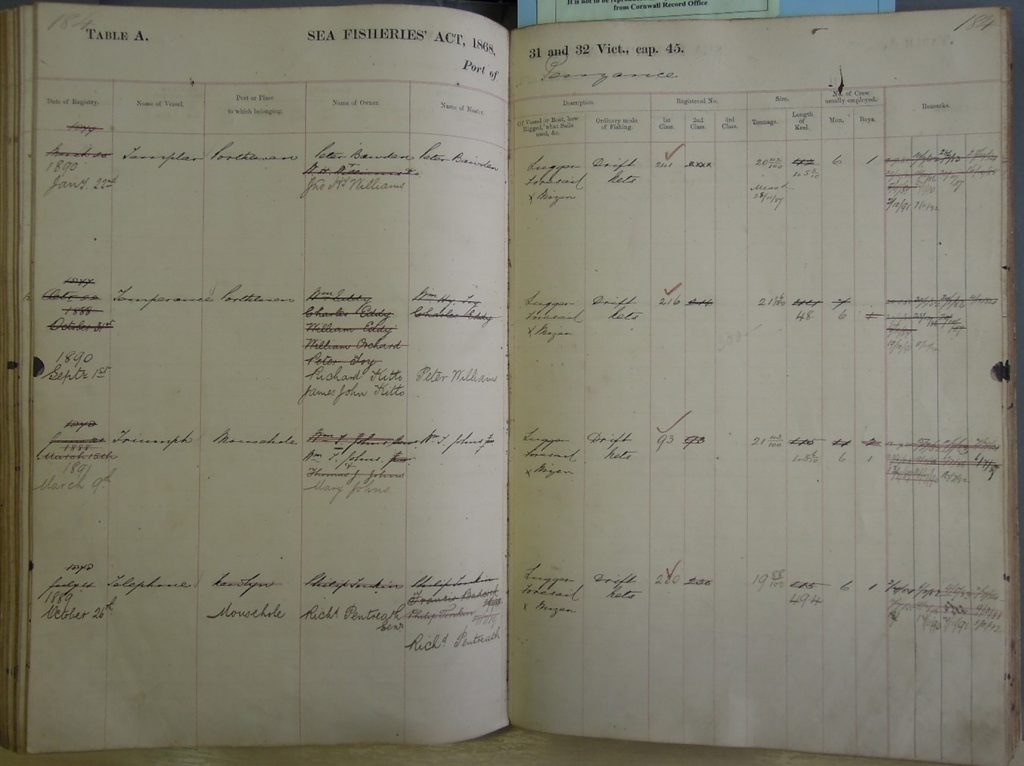
(Kresen Kernow: MSR/PENZ/6, folio 184)
During the period of this registration, her certificate of registry was endorsed annually, as being employed as a sea fishing boat each year from 1881, through to 1892.
In 1881, it would appear that the Telephone had been engaged in the North Sea herring fishery, as on Thursday, October 27th, under skipper Tonkin, she was reported to have sailed from Lowestoft, for Plymouth, with a cargo of pickled herrings – skipper Tonkin no doubt hoping to cover the cost of their homeward passage back to South Western waters. [9]
Under Tonkin’s command, she was one of the Mount’s Bay luggers that ventured in the North Sea herring fishery in the summer of 1883, making Whitby their temporary home port for the season. –
NEWLYN, July 30. – Sailed – Orion, Nicholls; Monarch, Murrish; Presto, Nicholls; Telephone, Tonkin, fishing luggers for Whitby.
Western Daily Mercury, July 31st, 1883
The lugger Telephone was still quite a new boat when she entered the lists of the First-Class luggers, in the Mount’s Bay Regatta, which took place off Newlyn on Monday July 8th, 1884.
FIRST-CLASS FISHING BOATS, not exceeding 46 feet keel. First prize £10, with silver cup value £3 10s; second £5, third £1 10s. The following entered: –
| Names and numbers | Owner |
| Activity, 353 | T. J. Matthews, Mousehole |
| Temperance Star, 59 | Thomas Strick, Newlyn |
| Thomas Harvey, 385 | Thomas Harvey, Newlyn |
| Empress, 165 | W. and A. Williams, Newlyn |
| Telephone, 230 | Philip Tonkin, Newlyn |
| Favourite, 147 | Mrs. Kelynack, Newlyn |
| Expert, 206 | John Barnes, Newly |
All entered put in an appearance, and a splendid start was effected at 1.50. The distance run was about 30 miles, from the committee boat to a boat moored off Marazion; thence round Mount Mopus Buoy, just inside Porthleven Bay, thence round a boat moored off Mousehole Island; thence to the committee boat; and a similar round again. Immediately after the start the Favourite led. The top-sail of the Thomas Harvey went away just after the start had been made. After the first point was passed, the Expert and the Favourite lost their mizen-gear. At the conclusion of the first round, the competing boats passed the committee boat in the following order –
Temperance Star and Activity at 3.27. The Temperance Star came in leading by about half a boat’s length, but in the centre of the committee boat the Activity passed her. At 3.32 the Thomas Harvey passed the committee boat, very closely followed by the Empress. After an interval of another five minutes the Expert, closely followed by the Favourite, passed. Two minutes later still the Telephone rounded the committee boat. The times occupied in the first round were thus:
| Temperance Star and Activity | 1h. 37m |
| Thomas Harvey and Empress | 1h. 42m |
| Expert and Favourite | 1h. 47m |
| Telephone | 1h. 49m |
The race was concluded as follows:
| Boat | Time occupied |
| Activity (1st prize) | 3h. 13m |
| Temperance Star (second prize) | 3h. 15m |
| Empress (3rd prize) and Thomas Harvey | 3h. 18m |
| Expert | 3h. 20m |
| Favourite | 3h. 25m |
The Telephone, being behind all the other competing boats, put into Penzance on the second round. The Thomas Harvey lost the third prize by about half a boat’s length, she being only that distance (and perhaps scarcely so much) behind the Empress at the winning post. The race was regarded by the numerous spectators as a very well contested one.2
On July 28th, 1888, after the close of the home mackerel fishery, Francis Badcock, was endorsed as skipper of the Telephone, in Philip Tonkin’s place. No reason is apparent for this change, but twelve months later, on July 17th, 1889, Philip resumed his place as skipper, but only for a brief period.
While working out of Newlyn she had moorings between the slips, where she lay alongside others of her class between fishing trips, and in off-seasons.
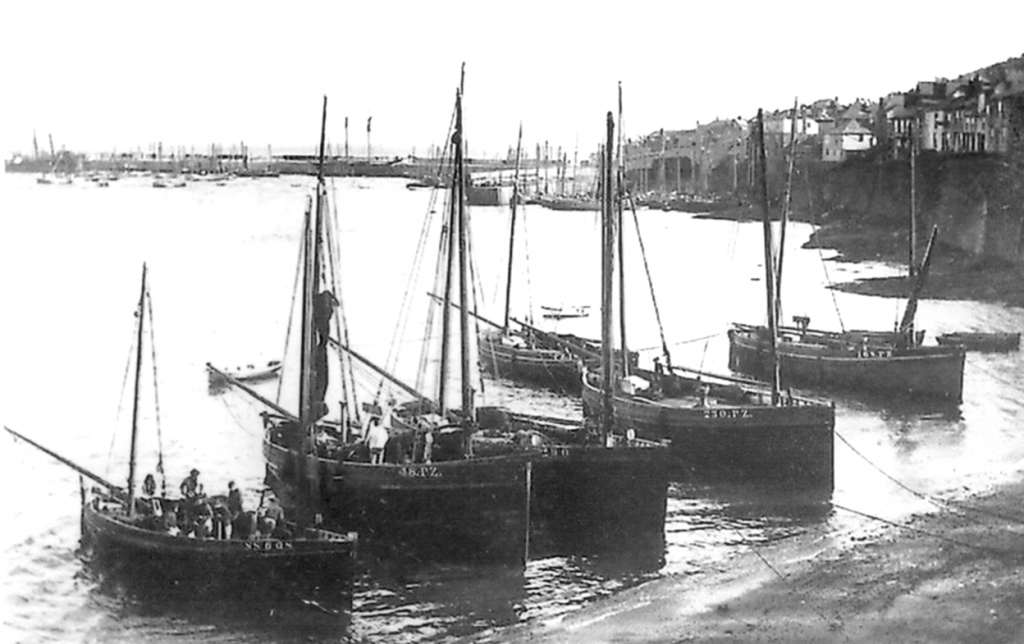
Three months after Philip Tonkin resumed command of the Telephone, he disposed of her, she was then in her eleventh year.
Out of Mousehole.
The Telephone was then acquired by Richard Pentreath (senior), of Mousehole, which now became her home port. At this time Richard had the Telephone re-measured under recently introduced regulations, by which, though the lugger was physically unchanged, she was registered on October 26th, 1889, as being 49.4 feet long overall, with an unchanged keel length of 45 feet, but by measurement she was now deemed to be of 19.88 tons – which brought her into the ranks of the first-class of sea fishing boats. As such her fishing number was re-configured as PZ.230, on her bows, sails, and fishing gear.
By the 1891 Census, Richard Pentreath was a 70-year-old, fisherman, and Elizabeth, his wife, was 64, with Richard (junior) aged 28, and his brother Edward, 26, were single fishermen, living at home with their parents, in No.8, Duck Street, Mousehole.
Mousehole Regattas.
Over a number of years, the Telephone served as committee-boat during Mousehole regattas. The first of which was held on July 27th, 1889, when Richard Pentreath had lent his old lugger Wanderer ~ 142.PZ, for that purpose. She was disposed of in February 1890, and was replaced by the Telephone, as committee-boat in 1890, a situation which she was to hold on a number of occasions over the next six years – but not invariably, the Britannia filling that role in 1891. Two of the moving forces behind the regatta series were Richard Treeve Harvey, and Bruce Wright, two sons of Mousehole. Harvey having made a career elsewhere, came home to Mousehole for his summer holidays, and teaming up with his old mate Bruce Wright they proved to be the principal regatta organisers for the next six years, raising funds and support wherever they could.
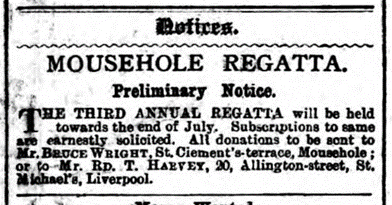
Which advert ran from April to July, with similar notices each succeeding year until 1895, when the lugger Telephone once more took up moorings between ‘Island and Shore,’ as committee-boat. Unfortunately, while the regatta itself was enjoyed by great numbers, it was to many a free-show, and this year there had been a lack of financial support from some of the villagers, which raised a shadow over the whole proceedings.
MOUSEHOLE REGATTA.
THE SECRETARY TAKES NO MORE INTEREST IN IT.
The seventh annual Mousehole regatta took place on Saturday and was patronized by Mr. T. B. Bolitho, M.P., the Mayor of Penzance (Mr. W. H. Julian,) Mr. R. F. Bolitho, Rev. R. W. Aitken, and others. The Telephone, kindly lent by Mr. Richard Pentreath, served as a committee-boat, and was anchored between Mousehole and the Island. An excellent selection of music was performed by the Paul brass band (under Bandmaster Osborne.) The affair was satisfactorily carried out by the following committee: – Messrs. W. J. Humphreys, Richard Pentreath, Henry Downing Potter, William Harris, Bruce Wright, and Richard Treeve Harvey; and to the last two is due much praise for getting up a good afternoon’s amusement. They spared no pains in making Mousehole regatta a great success. [12]
Cornishman, Thursday, August 8th, 1895
There followed a full report of the regatta events, and the prize giving in the evening, to which was added a sad footnote. The secretary, Richard Treeve Harvey, expressed his regret that this year, when going round the village to collect funds in support of the event, he had met ‘huff s and jeers of indifference.’ Discouraged, he resigned as secretary, and no Mousehole regattas were held for several years following.
Excluding these short diversions, the Telephone was a mackerel driver through and through, pursuing these elusive fish every season, from early February to late July, and then venturing ‘abroad’ to one or other of the Irish herring, or mackerel fisheries, or the North Sea, herring fishery, or in the winter the Plymouth herring season.
Richard Pentreath (senior), aged 71, died on September 30th, 1893, with his widow Elizabeth being granted probate on the 13th of December, when Richard’s effects were valued at £257 10s.
On March 1st, 1897, the Telephone’s details were transferred to a new register, with Richard Pentreath (senior) [deceased], still being recorded as her sole owner and Richard Pentreath as her skipper – presumably the second son of the previous Richard Pentreath, deceased.
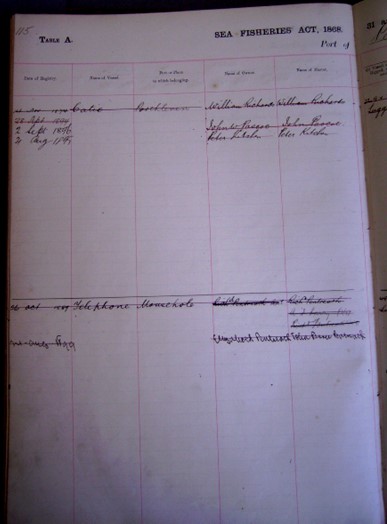
(Kresen Kernow: MSR/PENZ/7, folio 115)
However, as this transfer was for fiscal reasons, out of date information was transferred as current. Unfortunately, these independent fishermen were not particularly fussed about keeping the official records up to date. – they knew whose boat it was without a paper trail.
During the home mackerel fishery of 1895, skipper Richard Pentreath, brought his lugger to the aid of a fellow Mousehole men in distress.
COLLISION. – On Good Friday a barque bound to Falmouth, for orders ren into the Gleaner, fishing boat of Mousehole, carrying away the rail, bulwarks, and raft. The ship was boarded by the fishermen, and the captain of the barque admitting fault agreed to pay £20 to the owners of the Gleaner, and £5 to the Telephone, of Mousehole, to tow her into port. These terms were accepted.
Cornish Echo & Falmouth & Penryn Times, Saturday, April 20th, 1895
There is a family memory of a supposed even in 1895, when skipper Richard determined to force the maritime rule of the road, by making steam give way to sail. But, unfortunately, no newspaper account of such an incident has been traced.
On March 3rd, 1897, an A. J. Harvey [or Harry?], was endorsed as skipper of the Telephone, and a little over a month later, on April 12th, 1897, Richard Pentreath was again endorsed as skipper.
A couple of years later, on August 24th, 1899, sole ownership of the Telephone was vested in Elizabeth Pentreath, with John Pearce Pentreath as her skipper. By the 1901 Census, John P. Pentreath, was a 47-year-old Drift Fisherman, working on his own account. His wife Elizabeth, was 42, and they had four children, living with them in Mill Pool, Mousehole. However, I believe that the Elizabeth Pentreath registered as sole owner of the Telephone, was John’s mother, wife of the late Richard Pentreath, and not John Perace’s wife Elizabeth.
Heavy usage took its toll, and a new 32ft. foremast was made for the Telephone, by H. N. Peake, of Tolcarne, Newlyn, prior to the commencement of the 1905 mackerel season. Fortunately, we have access to Peake’s accounts ledgers of this period, by which we learn that the cutting and making of the new mast cost £3, against which a part payment of £2, was made in the following October.
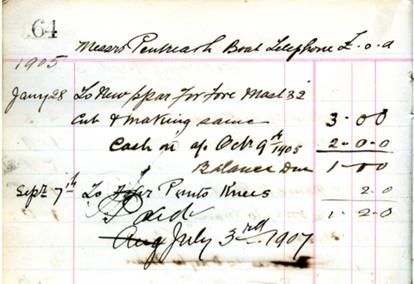
By that time Peake’s had also carried out a small repair to the knees of the Telephone’s punt at a cost of two-shillings. Reflecting the hand-to-mouth state of the fishery at this time, the outstanding balance of £1 2s. was not cleared until July 3rd,1907.

The punts of the Mousehole luggers were much the same as any other 12-foot fishing boats punts of the period, but were worked in a way peculiar to Mousehole. In the home mackerel fishery, when working daily out of Mousehole, the luggers frequently left their punts at home, in the hands of a boy, who was known as a ‘yawler.’ As the Mousehole luggers frequently landed their catches in Newlyn, to take advantage of a stronger market, it was the yawler’s job to scull the punt to Newlyn to land the catch, and bring off crushed ice, for the next trip. Yawler’s worth their salt, were alert to the return of their lugger, and would lay-to off the harbour in the hope of catching a line from their lugger as she sailed past at speed, so avoiding having to scull the couple of miles up to Newlyn – over the stern sculling that is.
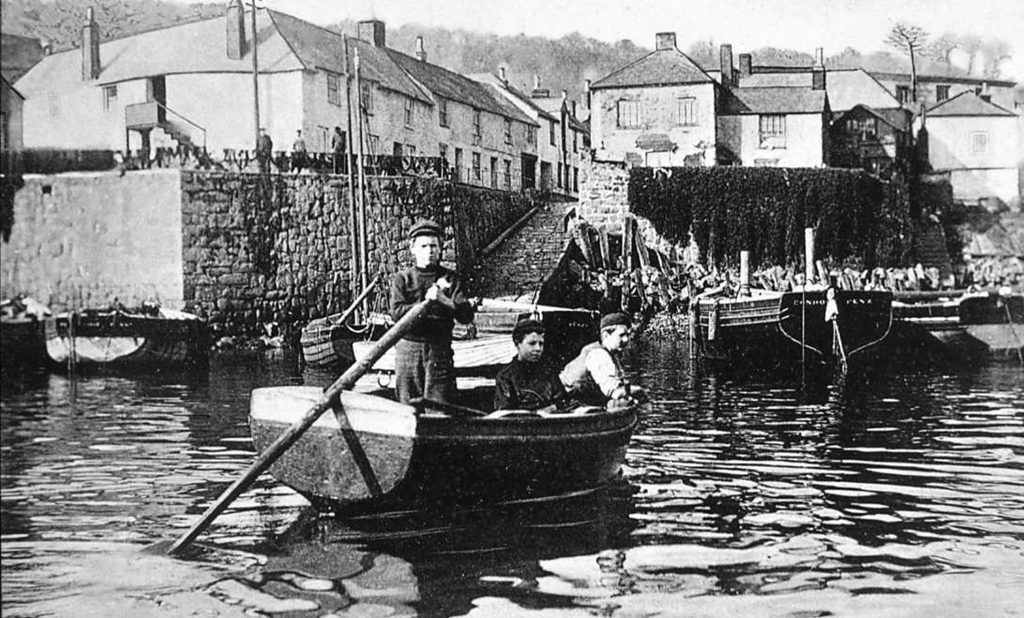
During the 1906 mackerel season, the Telephone was in collision with the Scillonian trading ketch Mount Carmel. Both Penzance papers gave the incident full coverage.
MOUSEHOLE.
A welcome improvement has shown itself in the fishing during the past week. No more cheering news could be found than that the boats fishing from Scilly have at last come in with mackerel though prices have dropped to a very low figure with the increased quantities of fish to hand.
Just as the fishery has taken a turn for the better it is indeed unfortunate that the Telephone, owned by Mr. Richard Pentreath, should have taken part in a collision which will be an expensive matter for the lugger, which, it is said was at fault. When entering St. Mary’s harbour last week the steersman of the Telephone did not observe the trading schooner Mount Carmel coming out and before the course could be altered the vessels met with great force. The Telephone had her stem badly damaged while the trader received even worse injury and it is estimated that £60 will be needed to repair the vessel. The Telephone was towed across to Mousehole and thence to Newlyn where she will be made seaworthy again. Much regret is felt for the unfortunate occurrence, bad enough at any time, but especially so now, when sucjh a trying period has been experienced.
Collision at Scilly.
The ketch Mount Carmel was proceeding across the roadstead on Wednesday morning about 7 o’clock in broad daylight and clear weather, when she was struck by the Penzance fishing boat Telephone, No.230. The Mount Carmel’s bulwarks, etc., were stove in but the damage was confined to the upper works. The Telephone’s stem appears to be badly damaged, and both vessels will have to undergo considerable repair.[16]
Cornish Telegraph. Thursday, May 17th, 1906
MOUSEHOLE BOAT IN COLLISION.
The ketch Mount Carmel was sailing from St. Mary’s to the island of Tresco, Scilly, on Wednesday, when she was run into by the Mousehole lugger Telephone, owned by Mr. Pentreath. The weather was clear, and all the drew of the lugger were on deck, but the foresail hid the ketch until it was too late to avoid a collision. The ketch was badly damaged, but the Telephone escaped with only her stem damaged.
At the time of the collision the crew of the Telephone were engaged in bending on the anchor, and did not observe the Mount Carmel working out. The latter sustained damage to the extent of £60, while the extent of the injury to the Telephone, which has since arrived at Newlyn, is about six pounds.
NEWLYN NOTES AND NEWS.
The lugger Telephone, of Mousehole, which was damaged in collision with the ketch Mount Carmel at Scilly last week, is now lying by the foot of the north pier having a new stem fitted by Mr. Henry Peake. [17]
Cornishman, Thursday, May 17th, 1906
The Mount Carmel, was one of the islands’ constant traders, principally employed in shipping cargoes of coal from the South Welsh ports. A fine 54-ton ketch, she was owned by Mrs. Rosamond H. Jenkins, and commanded by Capt. Ste’ Jenkins. The ketch had been built at Ponsharden, Falmouth in 1892, for Capt. John Hollow, of St. Ives. She had been acquired by Ste’ Jenkins, from him in 1897.
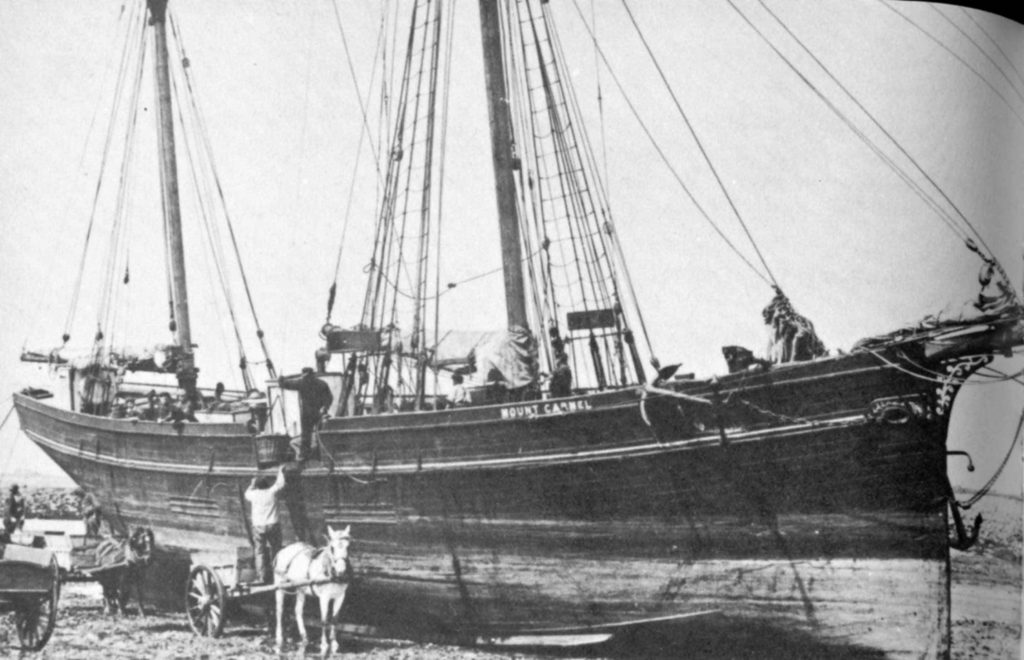
from ‘The Scillonian and His Boat,’ Alf Jenkins, 1982.
Fully repaired, the Mount Carmel continued in the island trade until 1917, when she came under the control of Cardiff manager, Howard E. Radford; but dropped out of the registers during 1918.
The repairs to the Telephone, entailed fashioning and fitting a new stem, which was completed on May 15th, and the estimated cost of near £6, was close to the mark, as noted in Henry Peake’s ledgers. –


After the incident with the Mount Carmel, there appear to have been no further reports about her in the local press – not even an occasional passing note during the next ten years – and this was her final decade.
Sometime in 1909, registration details to the Telephone were transferred to another register in a new more detailed format, though she was still registered in the sole ownership of an Elizabeth Pentreath. This ownership was post-dated as having occurred on May 2nd, 1906, though this register was not commenced until 1909. On that same date Elizabeth was also endorsed as sole owner of the Elizabeth ~ PZ396; a new, 26.2-foot, dandy rigged pilchard driver cum crabber, which remained on the register until 1917, when she was recorded as ‘no longer fishing.’ In this period many of the owners of ‘mackerel drivers,’ were also investing in ‘pilchard drivers,’ the mackerel fishery for the local boats being in hard hit by the remorseless fishing power of the East Coast steam drifters, made the venturing in the pilchard fishery seem a worthwhile option.
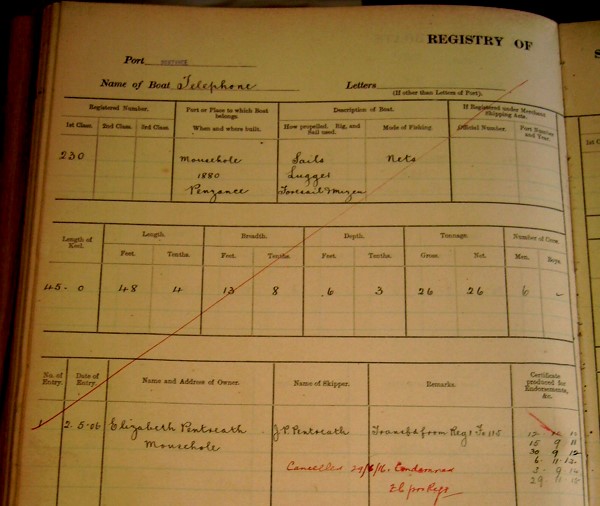
(Kresen Kernow: MSR/PENZ/9, folio 111)
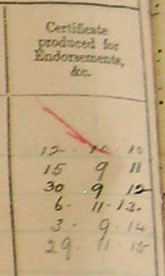
As mentioned previously, the Telephone would have frequently landed her catches in Newlyn, because of the better facilities there, and the stronger market. As such she would have paid harbour dues there, where in 1913, we find that her owner paid only two shillings, for Newlyn harbour dues, suggesting that she had only made an occasional landing of fish there in that year. However, she paid a full twenty-one shillings in 1914 – but none from 1915 on. All of which suggests that her fishing career was drawing to a close.
This is confirmed by the following enlargement of the annual record of her ‘Certificate produced for Endorsements &c,’ at the Penzance Custom House. 1915 would appear to have been her last year as a working fishing boat.
That she was not fishing in 1916 is partly confirmed by the fact that, from a rare account of Mousehole harbour dues for 1916, amongst the 81 boats named, there is no mention of the Telephone having made any landings in the harbour that year, nor of her having paid any other form of harbour dues.
Elizabeth Pentreath of Duck Street, Mousehole, had died on April 16th, 1914, when probate was granted to John Pearce Pentreath, fishermen. Her effects being valued at £424 10s. John was then in his 60’s, and mackerel driving was a young man’s fishery. By this time the Telephone was quite an elderly lady in her own right, being in her 37th year. As noted above, her Certificate of Registry continued to be endorsed annually up until November 29th, 1915, confirming that she was still a working fishing boat, but her days were numbered. On the close of the 1916 mackerel season the boat was condemned. Her registration as a sea fishing boat was cancelled on June 29th, 1916, and she was presumably broken up soon afterwards.
| Telephone‘s registered dimensions | 01/03/1897 |
| Length of Keel (ft.) | 45.0 |
| Length (ft.) | 49.4 |
| Breadth (ft.) | 14.2 |
| Depth (ft.) | 6.3 |
| Tonnage – tons gross | 19.88 |
| Tonnage – net reg | 19.88 |
| Number of crew – men | 6 |
| Number of crew – boys | 1 |
Tony Pawlyn
1 July 2022
